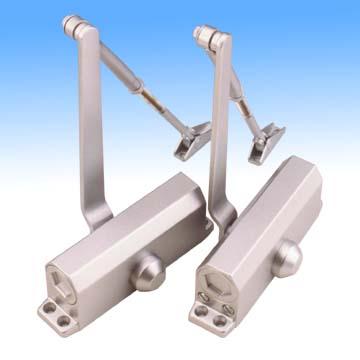 The door closer is a spring-like hydraulic device on the door head. When the door is opened, it can be released after being compressed. The door is automatically closed. It acts like a spring door and can ensure that the door is opened accurately and promptly to the initial position. .
The door closer is a spring-like hydraulic device on the door head. When the door is opened, it can be released after being compressed. The door is automatically closed. It acts like a spring door and can ensure that the door is opened accurately and promptly to the initial position. . Modern hydraulic door closers (referred to as door closers) began with a patent registered by Americans in the early 20th century. Unlike traditional door closers, they achieve cushioning by throttling the liquid in the door closer. . The core of the hydraulic door closer design philosophy is to achieve the control of the closing process, so that the various functions and indicators of the closing process can be adjusted according to the needs of people. The significance of the door closer is not only to automatically close the door, but also to protect the door frame and door body (smooth closing). More importantly, the door closer has become a non-negligible execution part of modern building intelligent management. Door closers are mainly used in commercial and public buildings, but they are also used at home. They have many uses, of which the main purpose is to close the doors themselves to limit the spread of fire and ventilation in buildings.
The working principle and types of door closers
The basic components of hydraulic door closers are: support guides, transmission gears, return springs, check valves, rack plungers, throttle bodies and housings, end caps, seals and connecting rods. The housing and linkage act as a fixed door closer and connect the door leaf and door frame.
The working principle of the door closer is that when the door is opened, the door body drives the connecting rod and rotates the transmission gear to drive the rack plunger to move to the right. The spring is compressed during the movement of the plunger to the right and the hydraulic oil in the right chamber is also pressurized. The one-way valve ball on the left side of the plunger opens under the effect of oil pressure, and the hydraulic oil in the right cavity flows through the one-way valve to the left cavity. When the door opening process is completed, since the spring is compressed during the opening process, the accumulated elastic potential energy is released, the plunger is pushed to the left, and the transmission gear and the door closer link are rotated to close the door.
During the spring release process, since the hydraulic oil in the left chamber of the door closer is compressed and the check valve is closed, the hydraulic oil can only flow out through the gap between the housing and the plunger and pass through the small hole in the plunger and 2 The flow path with the throttle body is returned to the right chamber. Therefore, the hydraulic oil constitutes a resistance to the release of the spring, that is, through the throttling to achieve the buffering effect, the speed of closing the door is controlled. The throttle valve on the valve body can be adjusted to control the variable door closing speed in different stroke sections. Although there are differences in the structure and size of the door closers produced by different manufacturers, the principle is the same.
The types of door closers can be divided into: exterior and embedded door top door closers, in-door door closers, door bottom door closers (floor springs) and other types of door closers.
Electric Ceramic Cooktop,Ceramic Surface Cooktop,4 Heating Zone Ceramic Cooktop,4 Burners Gas Cooktop Freestanding
Xunda Science & Technology Group Co.ltd , https://www.xundatec.com